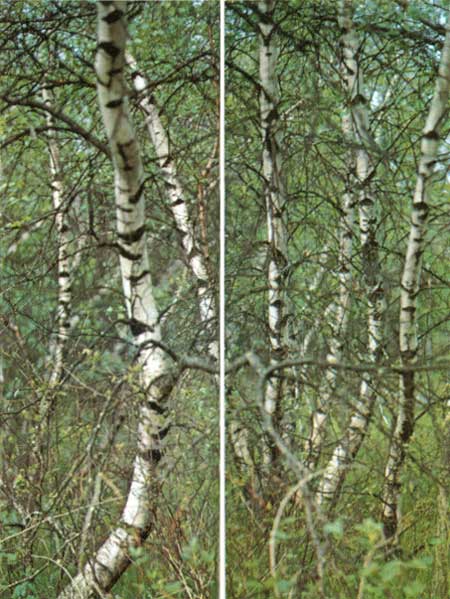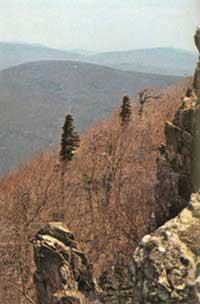|
SHENANDOAH National Park |
 |
Elements of the North
Ensconced in my sleeping bag in a small clearing on top of Hawksbill, I contemplated the night. Overhead, a myriad stars speckled the black sky. Far down the mountainside, a barred owl uttered doglike hoots. Although it was June 22, the breeze coming in from the west across the mountaintop chilled my feet. Feeling the cool air and catching the faint scent of nearby fir trees, I returned in thought to the many nights I had camped in the Adirondacks, summers before. It was a natural association, because here on Hawksbill, at 4,049 feet the park's highest peak, lower temperatures and abundant moisture make a home for numerous forms of northern plant and animal life. I had come here to see what some of those might be.
The next morning, after a fitful sleep (made so by cold feet, the rustling of a raccoon—or was it a bear?—and deer mice scurrying everywhere, including across me), I relished breakfast and the scene about me. A few yards off, the mountaintop fell away in cliffs, making an open view far out into the Shenandoah Valley. Around the clearing, short, twisted oaks and scattered dark firs gave a secure feeling, while juncos fed unafraid on the ground nearby. A rabbit (possibly a New England cottontail rather than the more widely distributed eastern cottontail) nibbled quietly on grass at the edge of the clearing. Back in the woods a veery sang, while from a brushy opening nearby came songs of chestnut-sided warblers. When I walked out to the cliff edge to get a better view, I found the little three-toothed cinquefoil, which grows in rocky, sterile places from Greenland south—even, on high mountains, to Georgia. Springing from crevices below me were mountain-ashes, with their fronds of narrow leaflets. Mingled with these plants and animals were many others of more temperate range, but the place did have a northern flavor.
 Big Meadows is the southernmost outpost of the gray birch, a northern species. (Photo by Hugh Crandall) |
Most indicative of all were the firs and spruces. Scattered among the red oaks, yellow birches, and other trees on the upper few hundred feet of Hawksbill, balsam firs and red spruces up to a foot thick survive here on a climatic island that is similar to climates of New England and the high peaks farther south, where firs and spruces also live. Presumably, they were more widespread in the Blue Ridge during the last ice age, and now with warmer climate have retreated to a few high-altitude spots. In southwestern Virginia and on down into the Smokies, there are lofty peaks that support sizeable forests of spruce and fir, which harbor animal life typical of this forest type. But Hawksbill is not high enough to have more than a sprinkling of these trees and thus lacks typical spruce-fir animals.
The transitional nature of the Hawksbill environment poses a problem for its northern conifers. Living as they do at the limit of their tolerance, could they withstand a series of warm, dry years? And does their precarious position make them more susceptible to disease and insect attack? One sign of health in a plant or animal population is vigorous reproduction, and in this respect Hawksbill's firs are doing well. You don't have to search long to find many seedlings beneath the parent trees. But look closely at the older trees and you will see a sign that may mean defeat. Toward the tips of many branches are bulbous swellings that mark the presence of the balsam woolly aphid, a tiny insect that sucks sap. Many other firs are dead, presumably killed by aphids. The spruces, though scarcer and less productive of seedlings, appear healthier. Perhaps in the long run, they will fit this environment better than their coniferous cousins.
My explorations that June day took me finally to the stretch of the Appalachian Trail that cuts across the steep north side of Hawksbill. This is a delightful, interesting, even spectacular walk that features all phases of the struggle of plants and animals (including our friend the Shenandoah salamander) to colonize and cover rocks. Along the way, on these cool, moist slopes, I found other species more typical of the north. There were Canada, blackburian, and black-throated blue warblers, veeries, juncos (one with a nest beside the trail), rose-breasted grosbeaks, and red squirrels. Beneath a canopy of rugged old yellow and black birches, ashes, red oaks, sugar maples and basswoods was a thick growth of shrubs, among which striped and mountain maple and ninebark were prominent. Along the path I found trailing monkshood, not actually a northerner but restricted, from Virginia and West Virginia south, to the mountains. In that wild jumble of rocks and vegetation, I concluded, many "cool" things wait to be found.
Seekers of northern life, of course, do not have to climb Hawksbill to find it. Many places above 2,000 feet have typical New England plants and animals, and some cool hollows carry such life almost to the foot of the mountains. But the higher places are better hunting grounds. Stony Man, at 4,010 feet a close second to Hawksbill, has much the same life. In addition, a few Canada yews grow here. Many of its spruces and firs, however, appear to have been planted, since these species are found mostly near trails between Skyland and the summit. Perhaps men of the Civilian Conservation Corps planted them back in the early days of the park, as they did the firs and spruces around Big Meadows.
Another "northern" environment is the Limberlost, a boggy area at the head of White Oak Canyon that is shaded by giant hemlocks and white oaks several centuries old. Hidden among the hemlocks a few large red spruces and a number of small ones attest to the elevation (3,300 feet) and the dampness. In the dark, acid world under these tall conifers few plants grow. But here and there among the scattered ferns you may find blooming such northerners as Canada mayflower, bluebead-lily, and wood sorrel. The bird population has its cool-zone representatives, too: blackburnian warblers, with fiery-orange breasts and weak, sibilant songs; and veeries, juncos, solitary vireos, and black-throated blue warblers. Among more secretive forms of life, the red-backed vole, a mouselike rodent that ranges north to Hudson Bay, undoubtedly lives here.
 Scattered firs tower over a stunted oak forest on Hawksbill Mountain. (Photo by Hugh Crandall) |
Visitors to the southern section of the park can see a smaller edition of the Limberlost on the east side of Skyline Drive just north of the turn-off to Loft Mountain. Here, where a number of northern plants grow on a mossy floor under hemlocks, one can expect the same species of birds found in the Limberlost.
A very unexpected northerner grows in and around the swamp at Big Meadows. This is the gray birch, best known as a reclaimer of old fields in New England. The colony at Big Meadows is near the species' southern limit and is its only known occurrence in Virginia. Perhaps its presence here can be laid to long-ago fires, which created the sort of opening it needs. Big Meadows Swamp, though now sucked partly dry by wells and drainage ditches, still harbors other plants that range mainly northward. One of the most conspicuous of these is Canadian burnet, which produces showy white flower spikes in late summer. Another is marsh marigold, blooming yellow in April and May.
Although the higher elevations and greenstone underpinnings in the central section of the park have a large share of Shenandoah's northern life, medium elevations and sedimentary rock in the southern and northern sections claim most of the park's paper birch, another hanger-on at the southern limit of its range. Most of the 50-or-so clumps of birch are hard to find, but several are easily seen on the north side of the ridge trail leading out to The Neighbor, in the north section. Charles (Mo) Stevens, who has roamed the ridges and hollows of the Blue Ridge for years, found under one stand of paper birch a colony of bunchberry, the first record for Virginia of this primarily Canadian plant.
Ranging at all elevations but most often seen flying over high ridges, ravens impart a feeling of the Canadian wilderness. For in eastern North America ravens are found primarily north of our border in vast coniferous forests and Arctic tundra. The southern Appalachians, however, harbor a sizeable population of these big, black birds. Distinguished from their cousin, the common crow, by much greater size, heavier bill, and wedge-shaped tail, ravens also identify themselves from afar with hoarse croaks rather than caws. Subsisting to a large extent on carrion, they patrol Skyline Drive seeking road kills; but they take food wherever they can find it, whether this be on a berry bush, in a bird's nest, or crawling across the forest floor. In March they lay their eggs in nests on sheltered cliff ledges, and by April they are feeding young. All summer the adult ravens tend their airborne though still-dependent offspring. In winter, ravens seem to range more widely, sometimes appearing in the nearby lowlands and occasionally even on the coastal plain. Throughout the year, Shenandoah would hardly be Shenandoah without the soaring and aerobatics, the raucous sounds, and the clever ways of this wilderness bird.
All the forms of northern life persisting in Shenandoah are of secondary importance here, ecologically speaking; but they do represent one environmental extreme in the park, and they have a special attraction for naturalists from the warmer lowlands. What better way, indeed, to spend a June day than to climb Hawksbill seeking bits of New England?

|

|
| NPS History | History & Culture | National Park Service | Contact |
|
Last Modified: Sat, Nov 4 2006 10:00:00 pm PST |


